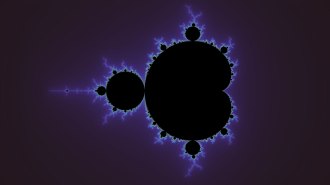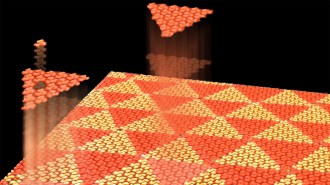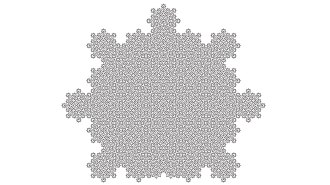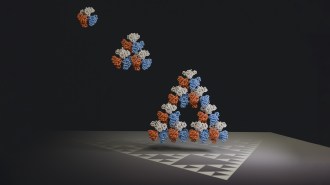Magic squares have fascinated people for thousands of years. They consist of a set of whole numbers arranged in a square so that the sum of the numbers is the same in each row, in each column, and along each diagonal.
Some magic squares have special properties, such as using only consecutive numbers. In ancient China, a three-by-three square that uses all of the digits from 1 to 9 was said to bring good luck. The numbers add up to 15 in all rows, columns, and diagonals.
|
size=”2″>4 |
size=”2″>9 |
size=”2″>2 |
|
size=”2″>3 |
size=”2″>5 |
size=”2″>7 |
|
size=”2″>8 |
size=”2″>1 |
size=”2″>6 |
In 1986, puzzle enthusiast Lee Sallows of the University of Nijmegen in the Netherlands introduced a new form of magic square. He found magic squares for which the number of letters in the word for each number in a magic square generates another magic square.
Here’s an example. Start with the following magic square, in which each of the rows, columns, and diagonals adds up to 45:
|
size=”2″>5 |
size=”2″>22 |
size=”2″>18 |
|
size=”2″>28 |
size=”2″>15 |
size=”2″>2 |
|
size=”2″>12 |
size=”2″>8 |
size=”2″>25 |
Spell out the English word for each of these numbers to obtain the following array:
|
size=”2″>five |
size=”2″>twenty-two |
size=”2″>eighteen |
|
size=”2″>twenty-eight |
size=”2″>fifteen |
size=”2″>two |
|
size=”2″>twelve |
size=”2″>eight |
size=”2″>twenty-five |
Count the number of letters in each word and enter that number in the appropriate space of a blank three-by-three grid.
|
size=”2″>4 |
size=”2″>9 |
size=”2″>8 |
|
size=”2″>11 |
size=”2″>7 |
size=”2″>3 |
|
size=”2″>6 |
size=”2″>5 |
size=”2″>10 |
The result is another magic square–one in which the rows, columns, and diagonals add up to 21. This square contains the consecutive digits from 3 to 11.
Here’s another alphamagic square, in English:
|
size=”2″>8 |
size=”2″>19 |
size=”2″>18 |
|
size=”2″>25 |
size=”2″>15 |
size=”2″>5 |
|
size=”2″>12 |
size=”2″>11 |
size=”2″>22 |
It turns out that there is a surprisingly large number of alphamagic squares, not only in English but also in many other languages. Indeed, Sallows worked out procedures for readily constructing additional alphamagic squares.
In French, there is just one alphamagic square involving numbers up to 200. However, if the size of the entries is increased to 300, an additional 255 alphamagic squares occur. For entries less than 100, none occurs in Danish or in Latin, but 6 occur in Dutch, 13 in Finnish, and an incredible 221 in German.
Here’s a German alphamagic square:
|
size=”2″>fünfundvierzig (45) |
size=”2″>zweiundsechzig (62) |
size=”2″>achtundfünfzig (58) |
|
size=”2″>achtundsechzig (68) |
size=”2″>fünfundfünfzig (55) |
size=”2″>zweiundvierzig (42) |
|
size=”2″>zweiundfünfzig (52) |
size=”2″>achtundvierzig (48) |
size=”2″>fünfundsechzig (65) |
Indeed, if every number in a certain language happened to be written out with the same number of letters, you could get as many magic squares as you would care to imagine. However, squares with repeated entries are much less interesting than those in which entry is different.
It’s tempting to expand the search to include other possibilities. In English, is there a three-by-three square from which a magic square can be derived, which in turn yields a third magic square–a magic triplet?
Furthermore, are there any instances of four-by-four and five-by-five language-dependent alphamagic squares?
A quick search turns up several examples. The following table of numerical values is an example of a four-by-four alphamagic square in English:
|
size=”2″>26 |
size=”2″>37 |
size=”2″>48 |
size=”2″>59 |
|
size=”2″>49 |
size=”2″>58 |
size=”2″>27 |
size=”2″>36 |
|
size=”2″>57 |
size=”2″>46 |
size=”2″>39 |
size=”2″>28 |
|
size=”2″>38 |
size=”2″>29 |
size=”2″>56 |
size=”2″>47 |
There’s much more to be learned and investigated in the realm of higher-order squares.
“With the transition from order 3 to order 4, and higher, comes a concomitant jump in the perplexities confronting our advance, since hindsight reveals order 3 as a special, unusually tractable case,” Sallows wrote in an article describing his discoveries. “The problems involved having largely resisted solution so far, this higher ground has been barely surveyed, let alone exhausted.”
“As a result,” he added, “it is no exaggeration to say that for programmers and pencil-owners alike, there remain rich pickings to be had, given ingenuity and the will to explore.”






